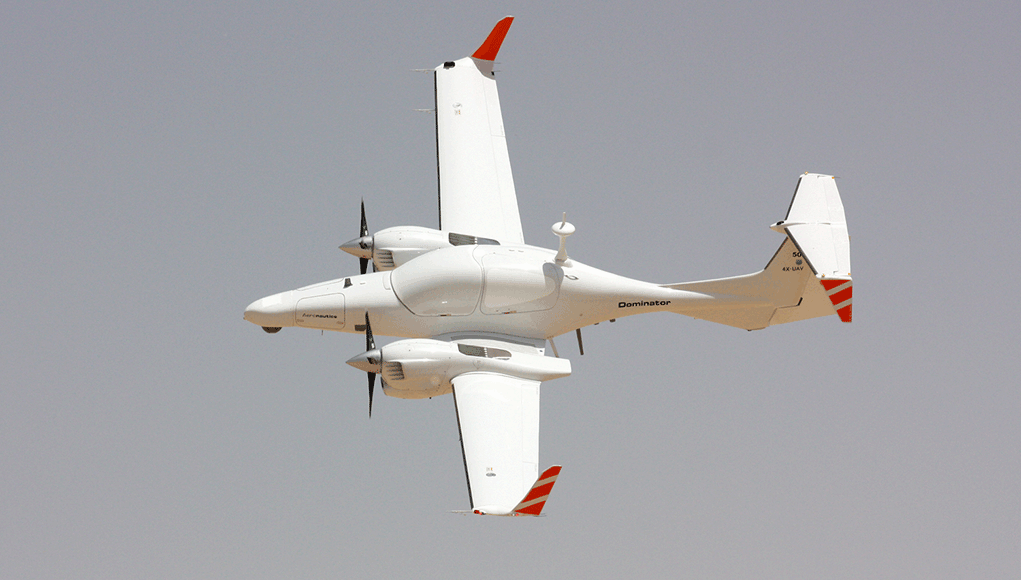Israel’s Unmanned Aerial Systems (UAS) producer Aeronautics announced today the award of a contract worth $27 million from an Asian government to supply Dominator XP Medium Altitude, Long Endurance (MALE) UAS. The Dominator XP is based on the Austrian Diamond DA-42 twin star aircraft converted by Aeronautics into an unmanned platform. The aircraft has a gross takeoff weight of 1,910 kg, including 373 kg in payload weight. Its mission endurance is 20 hours.
A few years ago only a handful of nations in Asia had access to MALE UAS, considered to be strategic systems offered only by the USA and Israel, namely the American Predator and Reaper, and Israeli Heron I, Hermes 450/900 and Dominator XP. The countries that were operating those drones in the region included Australia, Singapore, South Korea and India.
The introduction of Chinese drones has changed the picture. In recent years two Chinese MALE platforms have entered the market – Wing Loong 2 and CH4, these robust, and simple to operate drones enabled many more countries to obtain MALE UAV capabilities. Current MALE drone operators in the region include Pakistan, Myanmar, Turkmenistan, Azerbaijan, Kazakhstan, Uzbekistan, and Indonesia, along with South Korea, India, Singapore. Meanwhile, Australia phased out its Heron I and awaits to receive the MQ-4C maritime surveillance HALE drones ordered from the USA.
Turkey has also entered the field with two new platforms, the Anka MALE drone, and Bayraktar Tactical UAS, both are weaponizable, unmanned platforms.
[wlm_nonmember]
[/wlm_nonmember]
[wlm_ismember]Officially, the Israeli drones are not weaponized, but given the competitive market, such capabilities could be introduced.
The growing demand for MALE-class UAVs in Southeast Asia, particularly for systems providing maritime surveillance, assisting in human trafficking, smuggling, and counter-piracy operations. With their characteristic long endurance and long-range capabilities, such UAS enable persistent Intelligence, Surveillance, and Reconnaissance (ISR). Furthermore, as some of the platforms are also weaponizable, they can also perform limited strike missions on shorter missions, supporting ground and seaborne operations including border protection, counterinsurgency, anti-piracy and counter-terror activities.
Thailand has recently acquired MALE UAS and Bangladesh has also published a tender for such systems. With two Turkish drones entering the market, UAS competition in Asia is likely to increase.
The Royal Thai Army (RTA) has expanded its UAS capabilities this year with the acquisition of Hermes 450, becoming the second operator of this type in Southeast Asia. The $28 million contract included four Hermes 450 air vehicles, ground control stations, and support equipment. The Thai Army is one of the most experienced drone operators in SouthEast Asia. The unit receiving these drones has been flying IAI Searcher Mk II UAVs since 2001. The RTA also uses the Aeronautics’ Orbiter II mini UAS
The Royal Thai Air Force (RTAF) has an independent UAV unit, flying four Aerostar UAVs from Aeronautics and is likely the customer that acquired the Dominator XP in July 2018.
Dominator XP serves as a strategic asset, providing comprehensive ISR missions at ranges beyond line-of-sight. It is configured to operate multiple sensors and payloads simultaneously, including EO/IR and hyperspectral sensors, maritime search, SAR\GMTI radars, communications relays, COMINT, ELINT, Magnetic Anomaly Detection (MAD) systems and additional sensors.
According to the announcement the new acquisition enables the user, which already operates other Aeronautics UAVs, to extend the range and endurance of its UAVs, by flying longer range and carry multiple payloads.[/wlm_ismember]





















